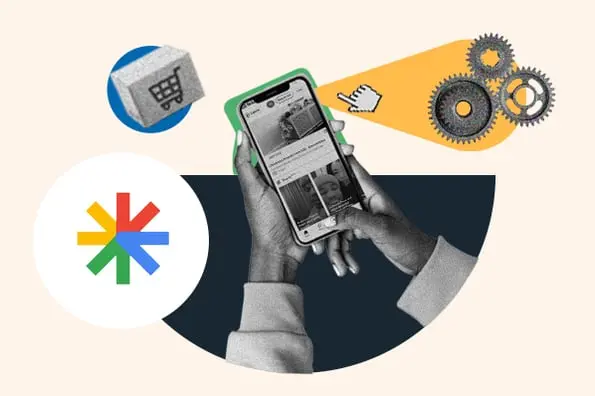Often, social media and SEO conversations happen separately.
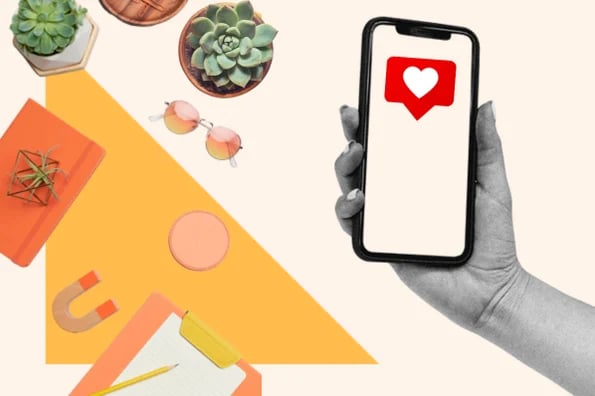
Social media is meant to build relationships and engage with your audience, while SEO seems more scientific, with specific keyword analyses to attract as many eyes as possible.
However, these two facets of inbound marketing can work together to amplify each other's results. In this blog, you'll realize that compromise is in sight.
This guide will help any marketer integrate their efforts across both platforms.
Below, we'll cover the following topics:
- Social Media vs. SEO
- What is social media SEO?
- 10 Social Media SEO Strategies
- Social Media SEO Strategies in Action
HubSpot uses the information you provide to us to contact you about our relevant content, products, and services. HubSpot will share the information you provide to us with the following partners, who will use your information for similar purposes: RYTE. You can unsubscribe from communications from HubSpot at any time. For more information, check out HubSpot's Privacy Policy. To unsubscribe from RYTE's communications, see RYTE's Privacy Policy.
.png)
Complete SEO Starter Pack
An introductory kit to optimize your website for search.
- Increase your organic traffic.
- Plan your keyword strategy.
- Debunk SEO myths.
- Build a blog strategy.
Social Media vs. SEO
Social media management relates to posting and optimizing your content on social media networks like Facebook, Twitter, or Instagram. SEO strategy relates to making your website or content more searchable so that people looking up phrases or questions about products or topics related to your industry will find your site in the results.
Now you know the difference between social media and SEO. So, let's dive into social media SEO.
What is social media SEO?
Social media SEO allows you to optimize your social profiles so you can better attract potential customers through search. SEO best practices will vary across platforms.
However, the goal remains the same: finding the right audience for your brand and exposing them to products they could buy.
While social media management and SEO optimization tend to be two very different strategies, they can complement each other. Leveraging both can help you gain traffic from a variety of different sources.
Our survey in January, involving 1,528 social media marketers, emphasized the growing importance of social media in 2024.
42% strongly agreed that people now prefer finding brands on social media rather than traditional search engines.
What's more, our findings suggest that in 2024, more people will buy directly from social media apps than from other channels. 82% said they'd choose social media over a brand's website, and 84% said the same compared to third-party sites like Amazon.
It's becoming increasingly clear: Social media is not only a place to connect with friends anymore. It's a connection spot between businesses and customers.
And will social search replace search engines?
No, both hold their ground because they serve different purposes.
People use Google to find an answer to a question. On the other hand, they use social media to discover answers to questions they haven't yet thought of.
The difference between search engines and social media platforms is blurring.
10 Social Media SEO Strategies
1. Social Sharing Buttons on Your Website
There's a lot of debate regarding the use of social media sharing buttons. Are they powerful tools or just unnecessary clutter?
Well, social sharing buttons can be effective if you place them strategically — for instance, on blog posts.
Grammarly does a great job using this method:
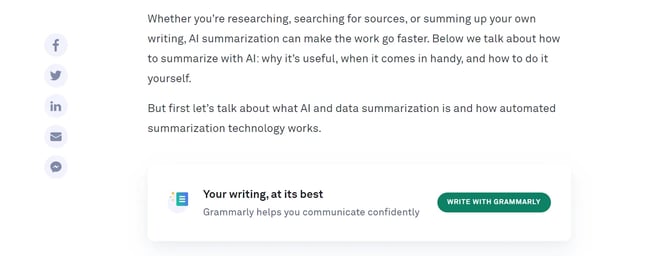
In other scenarios, social sharing buttons might not yield any results.
For instance, a VWO study suggests that removing those buttons from landing pages can increase click-through rates by 11.9%.
This indicates that while blog posts benefit from social sharing buttons, pages with clear goals may perform better without them. Conducting A/B tests can help you determine the best placement for social sharing buttons on your site.
2. Integrated Keyword Strategy
As mentioned earlier, the line between search engines and social media platforms is blurring. Take the keyword strategy you use for your website and apply it to your social media engagement when appropriate.
Do research and find what keywords are most popular for a particular platform you use.
For instance, in January 2023, Statista found that “how to…” keywords were the most searched terms on TikTok during the examined period. Following closely behind was the term “what is…” with an index value of 10.
Once you write the list of the top keywords for your social media posts, you can start creating them. But, don't overload your posts with too many keywords.
Instead, be aware of how you are wording social media messages. By incorporating keywords into social media content, you can increase the reach of your messages.
Here's how to identify the right keywords for each platform:
- Reflect on phrases that people might use to describe your business if they couldn't recall its name. For instance, for a productivity tool, users might search for terms like “task manager” or “organizer app.”
- Opt for more specific terms if there is significant competition. For example, a “budget-friendly travel app” might yield better results than simply a “travel app.”
- Select keywords that align with the associations you wish to establish. For instance, if you offer discounts, use something like “discount app,” “best deal,” etc.
- Revisit any previous SEO keyword research to incorporate relevant terms. Keywords that performed well in web searches may also be effective on social media.
- Tailor your keyword selection to suit the nuances of each platform. For instance, a restaurant might use keywords like “best restaurant in New York” on Facebook to attract guests, while on LinkedIn, terms like “hospitality jobs in New York” could attract talent.
3. Include Links in Social Profiles
The links in social media messages, such as tweets and Facebook status updates, are traditionally no-follow links. This means they don't pass any SEO authority to the site they're linking to.
But, before we continue, let me first debunk two myths about nofollow links:
- Nofollow links are useless. They may not boost your site's authority, but they can still drive traffic and potential customers.
- Nofollow links hurt your site. Not true. When used correctly, they can even improve your search ranking and shield you from penalties.
For example, comments on social networks or forum posts should have a nofollow link. It tells search engines that these links “aren't meant for advertising purposes.”
On the other hand, it's important to understand that the URL in the actual bio of a social media account is a follow link.
Make sure you are taking advantage of these extra opportunities to draw your audience to your site.
HubSpot uses the information you provide to us to contact you about our relevant content, products, and services. HubSpot will share the information you provide to us with the following partners, who will use your information for similar purposes: RYTE. You can unsubscribe from communications from HubSpot at any time. For more information, check out HubSpot's Privacy Policy. To unsubscribe from RYTE's communications, see RYTE's Privacy Policy.
.png)
Complete SEO Starter Pack
An introductory kit to optimize your website for search.
- Increase your organic traffic.
- Plan your keyword strategy.
- Debunk SEO myths.
- Build a blog strategy.
4. Incorporate Links Into Video and Presentation Content
Our stats suggest that short-form videos, like those on TikTok and Instagram Reels, have given the biggest ROI this year, with 36% of respondents choosing them. So, sharing links to TikTok and Instagram is a good idea for better engagement.
You can do the same on other social media platforms, too. For example, on LinkedIn, you can use carousels to break down your blog article into a few engaging slides and link back to that article.
You have two options for adding links to videos or presentations:
- If the social media platform allows, you can embed them directly into the video or slides.
- You can place the links in the description below/above the video or slides.
Both methods provide extra information or resources to your audience, improving their engagement with your content.
5. Optimize Social Profiles
Think of social media profile pages as extensions of your website.
Just as you would optimize website pages for page titles and keywords, audit your social media profiles to ensure they mirror your website's search engine optimization strategy.
This can fall under your About Us, Services, Products, or the other editable sections to help search engines further understand your website's relationship to those keywords.
Here are some tips on how to optimize it:
- Don't be anonymous — a profile pic is a must to establish credibility. Use eye-catching, high-quality images.
- Regularly update your cover photo on Facebook, Twitter, and LinkedIn. For instance, you can announce events or new releases.
- Add social badges to your website and email signatures to direct traffic to your profiles.
Use SEO-friendly keywords in the About section. Remember — only the first 140 characters show up in search results, so lead with essential info. - Link your website in your bio sections and make sure your website is mobile-friendly.
- Verify your account to get a verification badge. It helps to distinguish it from fake or fan accounts with your name. This study shows that verified badges on social media greatly affect how much consumers trust profiles and their posts. They also help make commercial posts more acceptable.
6. Building Links and Social Media Reach
Search engine optimization has long been about inbound links to your website. While inbound links are still significant, a secondary metric for marketers looking to increase search traffic should be social media reach.
In order to get more people to share your content on social media, you need to increase the number of fans or followers of your account.
However, don't pay for fake followers or likes, as the platform will likely catch and penalize you.
The Artios' study came up with concerning results — the number of fake followers is getting higher every year. Across platforms such as Instagram, TikTok, and Twitter, there's a rising trend of people seeking to purchase fake followers.
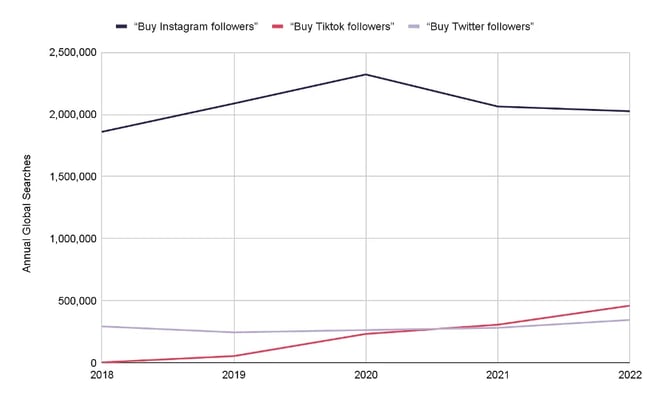
But trust me, buying followers doesn’t work. Sure, your numbers might look good, but what about the engagement? It's practically non-existent.
10k followers but only getting 10 likes per post? Doesn't add up, right?
Purchased likes are worthless as well. Those bots won't engage with your content, care about your brand, or turn into real customers.
Instead of enjoying fake fame, grow your reach through quality content creation and engagement. You will build not only social media reach but also inbound links.
7. Establish Relationships
Similar to sales, relationships are huge for driving inbound links and social media attention. Building relationships using social media can open opportunities for guest blog posts and other link-building opportunities.
You can also implement this by polling followers to drive engagement and responding to comments to show users there are real people behind the screen.
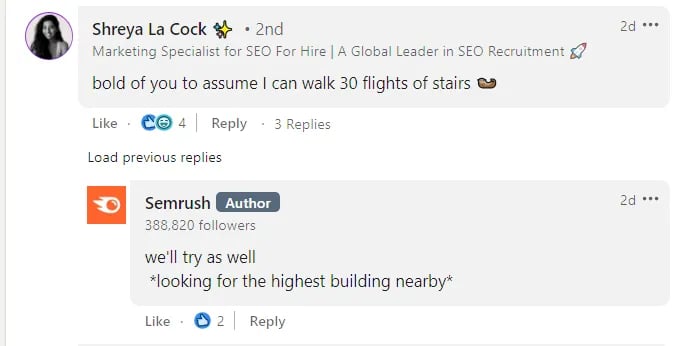
You can also nurture relationships by setting up groups/communities.
For instance, consider creating a Slack community where you can post valuable content and initiate discussions in an #announcement channel.
Also, create a Facebook or LinkedIn Group, host live events on X, Instagram, or TikTok, and interact with your audience to keep them engaged and informed.
According to our research, Facebook is the most effective platform for communities, with 48% preference, followed closely by YouTube at 46% and Instagram at 40%.
Engage with your followers as much as possible and wherever possible. These activities provide you with more opportunities to share additional links with your users.
8. Boost Your Content Creators’ Profiles
Search engines pay close attention to the creators of the content on a web page. In addition to the web, search engine crawlers pull information from social media platforms to better inform the credibility of the author.
Include author bios in your articles or blogs that are linked to their social media profiles and tag them with each new piece of content they produce.
9. Increasing Positive Mentions
As previously shown, having a robust social media presence can create a positive relationship with your audience.
A critical aspect of achieving this is to have online mentions that grow your brand's visibility and positive awareness.
Having a good social listening system can help you understand what customers are saying about you, manage your reputation, keep an eye on competitors, and plan your content better.
Based on the Social Media Today survey, nearly 61% of businesses currently have a social listening system in place to monitor keyword mentions.
And, if you see some content has good engagement, don't be afraid to recycle it or repurpose it. You can extend the content's life by recirculating it.
Google reports that positive online mentions can help determine whether your site is relevant in search queries.
Encourage positive mentions through engaging content and customized posts to the platform.
10. Collaborating with Influencers
Influencers shape the market today, so make the most of it.
According to Statista, influencers wield significant power over purchasing decisions. For instance, in Italy, 24 percent of shoppers admitted to buying products based on influencer recommendations in 2023.
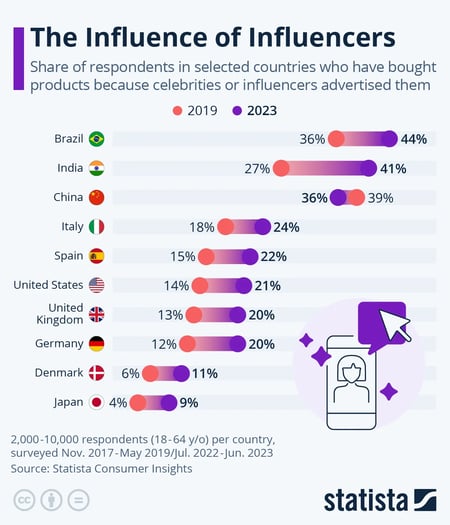
Here are several ways to collaborate with influencers:
- Pay them for featuring your brand.
- Use them in advertisements.
- Give them free products for reviews.
- Co-create products or launch new lines.
- Run giveaways together.
- Invite them to your brand's events.
- Establish a brand ambassador program for long-term relationships.
Overall, teaming up with influencers is a smart way to make more people aware of your brand, connect with your target audience, and drive meaningful engagement and conversions.
HubSpot uses the information you provide to us to contact you about our relevant content, products, and services. HubSpot will share the information you provide to us with the following partners, who will use your information for similar purposes: RYTE. You can unsubscribe from communications from HubSpot at any time. For more information, check out HubSpot's Privacy Policy. To unsubscribe from RYTE's communications, see RYTE's Privacy Policy.
.png)
Complete SEO Starter Pack
An introductory kit to optimize your website for search.
- Increase your organic traffic.
- Plan your keyword strategy.
- Debunk SEO myths.
- Build a blog strategy.
Social Media SEO Strategies in Action
Now that we understand social media SEO strategies in theory, let's explore how they work in practice and how popular brands implement them.
1. Adobe: Link Promotion & Influencer Collab
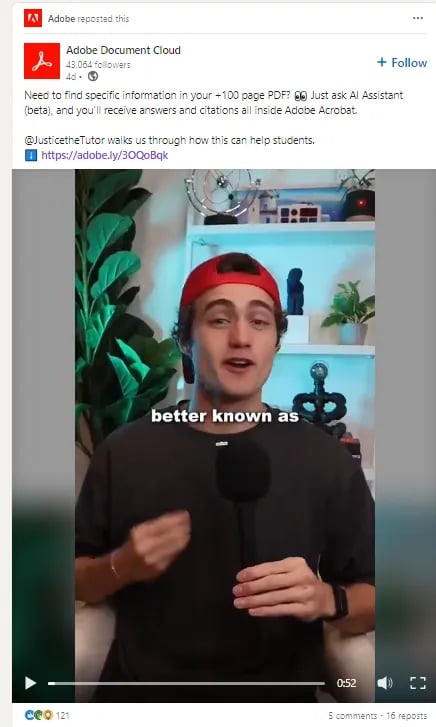
In this post, Adobe has embraced two of the strategies we discussed earlier.
Firstly, it uses video content to promote a link directing users to its website to learn more about the AI Assistant.
Furthermore, the video itself is crafted by Justice Shepard, a popular influencer in the tutoring community with 1.7 million followers on TikTok.
But this post wasn’t an exception.
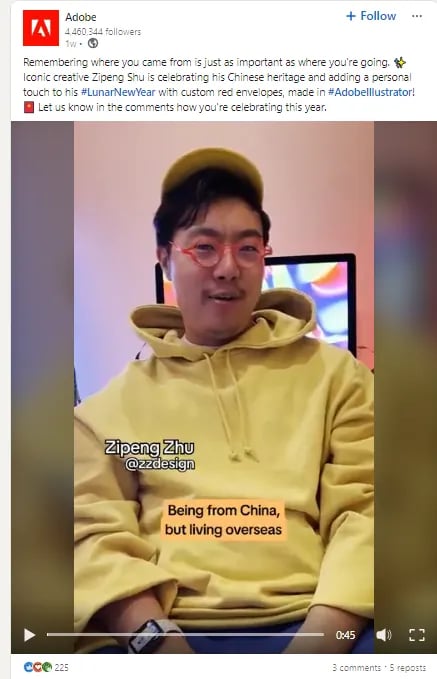
Adobe often uses influencer marketing through short-form videos, and it works pretty well.
HubSpot's data shows that 57% of Gen Z and 42% of millennials like learning about products through short-form videos. Social media marketers agree — it’s their go-to format, with 83% finding it most effective.
2. Girl Power Marketing: Casual Chatting & Engaging Through Comments
If I had to choose a brand that truly values every single comment on its page, Girl Power Marketing would be at the top of my list — always and forever.
It's nearly impossible to find a follower comment without a response.
And with over 100k followers, just imagine the sheer volume of comments they need to keep an eye on.
Yet, they still do.
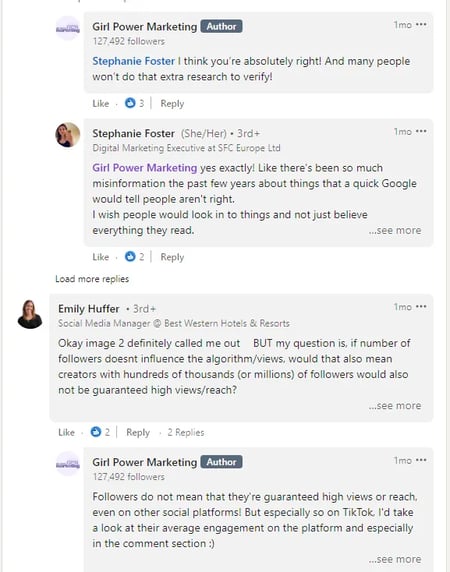
I love how these comments aren’t generic or boring — they feel personalized, like friendly advice or casual chatting.
“Just do the damn thing! Let go of the fear, and the idea of being perceived, and the idea of people finding you cringe. Have fun with it and be yourself. The more you try to manufacture a personal brand, the less authentic it becomes,” says Annie-Mai Hodge, founder of Girl Power Marketing.
This approach is a great example of how to maintain good engagement, attract new followers, make people love you, and ultimately improve social media SEO.
3. Ahrefs: Building Bridges With Creators
Ahrefs proudly showcases its blog writers with engaging introductions and profile pictures. Beneath each picture, there are buttons that directly connect to the writers’ social platforms.
Just like Ahrefs did, ask your writers or employees to mention your company name and share their work/pieces on social media.
It helps build trust with Google and shows your brand is authentic and legitimate.
Also, you'll notice Ahrefs often shares or reposts creators' posts on their LinkedIn. And what's the purpose of this action? They improve their social media SEO and credibility by showing a strong connection with the creators.
In this way, Ahrefs also sends a clear message to its followers — that it values diverse voices and appreciates everyone's efforts.
Getting Started With Social Media SEO
Whether social media has been a tactic in your SEO strategy or not, hopefully, you have gained a stronger understanding of how to link the two.
The content and product already exist. Now, it is up to you to implement these tips by working across teams and collaborating.
At the end of the day, each strategy will need to be tailored to your brand, so play around with the ten tips above to see which sticks.
![→ Download Now: SEO Starter Pack [Free Kit]](https://no-cache.hubspot.com/cta/default/53/1d7211ac-7b1b-4405-b940-54b8acedb26e.png)
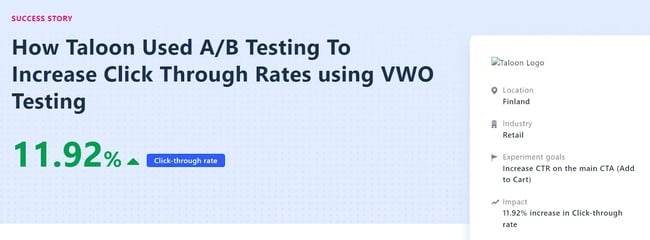



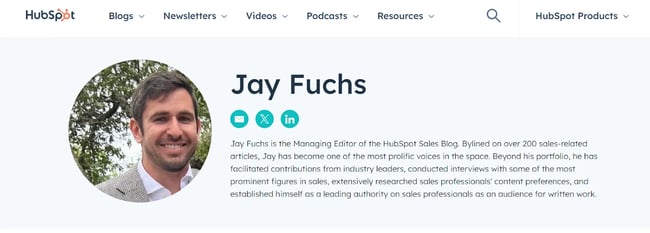
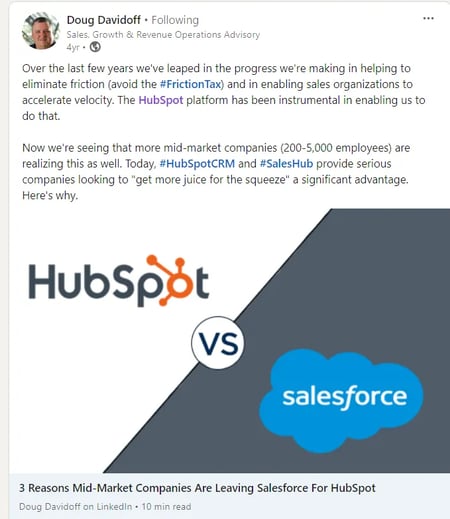



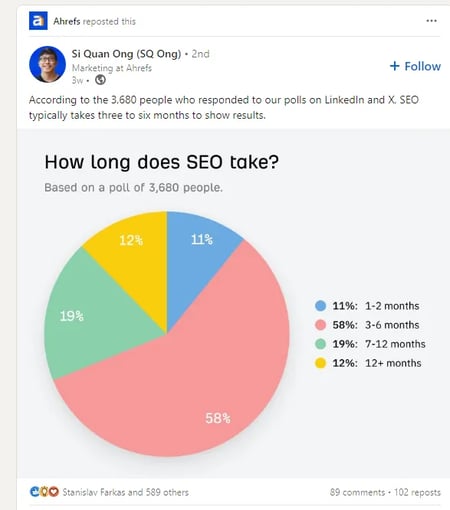


![The Ultimate Guide to Google Ads [Examples]](https://blog.hubspot.com/hubfs/adwords-ppc_4.webp)






